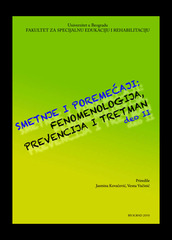Istraživanje samoubistva: otkrivanje društva
Exploring suicide: revealing society
| dc.contributor | Kovačević, Jasmina | |
| dc.contributor | Vučinić, Vesna | |
| dc.creator | Filipović, Mirko | |
| dc.date.accessioned | 2022-05-06T10:01:58Z | |
| dc.date.available | 2022-05-06T10:01:58Z | |
| dc.date.issued | 2010 | |
| dc.identifier.isbn | 978-86-80113-99-9 | |
| dc.identifier.uri | http://rfasper.fasper.bg.ac.rs/handle/123456789/4486 | |
| dc.description.abstract | Uticaj društva na samoubistvo predstavlja veliku enigmu koju sociolozi, počev od Dirkema, pokušavaju da odgonetnu. Determinante na koje je ukazao Dirkem u svojoj slavnoj studiji deluju i dalje, ali artikulisane na izmenjene načine. Stope samoubistva su snažno rasle tokom perioda industrijalizacije na Zapadu u 19. veku, ali su stagnirale ili opadale tokom čitavog 20. veka, uprkos starenju stanovništva. Ovo protivreči katastrofičkoj viziji po kojoj ekonomski razvitak nužno vodi patološkim formama individualizma, povećanoj izolaciji, te tako i većoj izloženosti samoubistvu, i navodi na razmišljanje o novim formama socijabilnosti koje imaju zaštitnu funkciju u najrazvijenijim modernim društvima. Snažno povećanje stopa u Kini (inače, jedinoj zemlji u kojoj je stopa samoubistva žena veća od stope samoubistva muškaraca), Indiji i Rusiji u 20. veku, možda ukazuje na slične obrasce destabilizacije društva povezane sa industrijalizacijom kakve je Zapad poznavao u 19. veku. Možda je najupečatljiviji rezultat novijih istraživanja preokret u stopama po godinama starosti u najrazvijenijim zapadnim zemljama. U Dirkemovoj eksplikativnoj šemi, pravilno povećanje stopa sa starošću tretirano je kao „prirodna činjenica“. Međutim, počev od petrolejskih kriza 70-tih, stope samoubistva mladih snažno rastu, dok stope samoubistva starih stagniraju ili opadaju. Snažan porast kod mladih ukazuje na krizu u konstrukciji identiteta gde su nezaposlenost, dekvalifikacija, neizvesnost i nesigurnost na tržištu rada istovremeno i znak nepriznavanja lične vrednosti od strane društva. Uz to, Dirkemov zaključak „la misère protège“ više ne stoji, bar za razvijene zapadne zemlje: stope pravilno rastu kako se ide od vrha prema dnu društvene hijerarhije. Broj samoubistava sledi kretanje društva, na duži i kraći rok. Ako je društvo u stanju da stavi svoj pečat na tako lični čin kao što je samoubistvo, ono to čini sa još većom snagom na druge aspekte života. | sr |
| dc.description.abstract | The impact of society on suicide is an enigma that sociologists have tried to solve since Durkheim s famous study. Many forces indicated by Durkheim have continued to act, but they are articulated differently today. Suicide rates were heavily increasing during industrialization period in the West in !9.th century, but they were decreasing during 20.th century. This contradicts the catastrophic vision in which economic development unavoidably leads to pathological forms of individualism, isolation, and thus to greater exposure to suicide, and induces thinking about new forms of sociability having protective function, generated in modern developed societies. Increasing suicide rates in China (the only country where female suicide rate is higher than that of males), India and Russia may point to similar social destabilization patterns which had been connected with the industrialization of the West in 19. century. But maybe the most striking result of contemporary research is the turnover of suicide rates according to ages of life. In Durkheim’ s explication scheme regular an increase in suicide rates with aging was seen as a „natural fact“. However, starting with the petrol crisis in the 70s, suicide rates of the young have grown, and those of the old have clearly stagnated or decreased in developed western countries. This strong growth points to the crisis of identity construction, where the unemployement, dequalification and uncertainty of the job market are in the same time a sign of social denial of individuals personal value. Nevertheless, Durkheim’s conclusion „ La misère protège“ doesn’ t seem to be valid any more: sucide rates regularly increase from the top to the bottom of social hierarchy. Suicide rates follow the mouvements of society in both large and short scale. If society is able to put its sign on such a personal act as a suicide, it does it even more efficiently on the other aspects of life. | sr |
| dc.language.iso | sr | sr |
| dc.publisher | Univerzitet u Beogradu – Fakultet za specijalnu edukaciju i rehabilitaciju/ University of Belgrade – Faculty of Special Education and Rehabilitation | sr |
| dc.rights | openAccess | sr |
| dc.rights.uri | https://creativecommons.org/licenses/by-sa/4.0/ | |
| dc.source | Zbornik radova - „ Smetnje i poremećaji: fenomenologija, prevencija i tretman deo II / Disabilities and Disorders: Phenomenology, Prevention and Treatment Part I I “,Beograd / Belgrade 2010 | sr |
| dc.subject | samoubistvo | sr |
| dc.subject | privredni razvoj | sr |
| dc.subject | društvena integracija | sr |
| dc.subject | društvena klasa | sr |
| dc.subject | rod | sr |
| dc.subject | doba starosti | sr |
| dc.subject | Suicide | sr |
| dc.subject | Economic development | sr |
| dc.subject | Social integration | sr |
| dc.subject | Social class | sr |
| dc.subject | Gender | sr |
| dc.subject | Age of life | sr |
| dc.subject | Religion | sr |
| dc.title | Istraživanje samoubistva: otkrivanje društva | sr |
| dc.title | Exploring suicide: revealing society | sr |
| dc.type | conferenceObject | sr |
| dc.rights.license | BY-SA | sr |
| dc.citation.epage | 440 | |
| dc.citation.spage | 425 | |
| dc.identifier.fulltext | http://rfasper.fasper.bg.ac.rs/bitstream/id/7650/Untitled30.pdf | |
| dc.identifier.rcub | https://hdl.handle.net/21.15107/rcub_rfasper_4486 | |
| dc.type.version | publishedVersion | sr |


